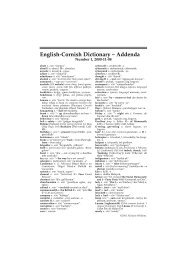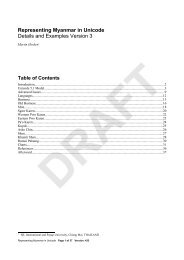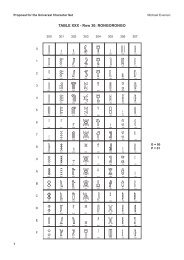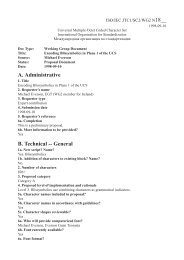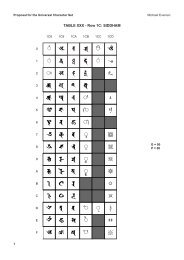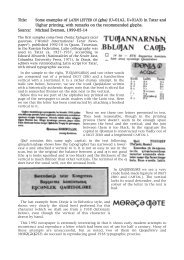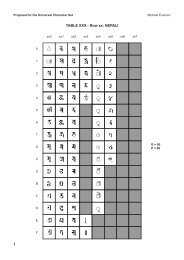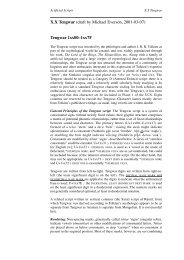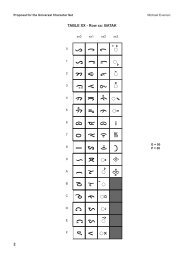Final text for Latin/Greek alphabet TITLE PAGE - Evertype
Final text for Latin/Greek alphabet TITLE PAGE - Evertype
Final text for Latin/Greek alphabet TITLE PAGE - Evertype
You also want an ePaper? Increase the reach of your titles
YUMPU automatically turns print PDFs into web optimized ePapers that Google loves.
ISO/IEC 8859-7:2003 (E) © ISO/IEC<br />
ISO/IEC 2022: 1994, In<strong>for</strong>mation technology –<br />
Character code structure and extension techniques.<br />
ISO/IEC 4873: 1991, In<strong>for</strong>mation technology – ISO<br />
8-bit code <strong>for</strong> in<strong>for</strong>mation interchange – Structure<br />
and rules <strong>for</strong> implementation.<br />
ISO/IEC 8824-1: 1995, In<strong>for</strong>mation technology –<br />
Abstract Syntax Notation One (ASN.1):<br />
Specification of basic notation.<br />
4 Definitions<br />
For the purposes of this part of ISO/IEC 8859 the<br />
following definitions apply:<br />
4.1 bit combination: An ordered set of bits used<br />
<strong>for</strong> the representation of characters. (fr: 4.3)<br />
4.2 byte: A bit string that is operated upon as a<br />
unit. (fr: 4.2)<br />
4.3 character: A member of a set of elements<br />
used <strong>for</strong> the organization, control, or representation<br />
of data. (fr: 4.1)<br />
4.4 code table: A table showing the characters<br />
allocated to each bit combination in a code. (fr: 4.9)<br />
4.5 coded character set; code: A set of<br />
unambiguous rules that establishes a character set<br />
and the one-to-one relationship between the<br />
characters of the set and their bit combinations. (fr:<br />
4.5)<br />
4.6 coded-character-data-element (CC-dataelement):<br />
An element of interchanged in<strong>for</strong>mation<br />
that is specified to consist of a sequence of coded<br />
representations of characters, in accordance with<br />
one or more identified standards <strong>for</strong> coded<br />
character sets. (fr: 4.4)<br />
4.7 graphic character: A character, other than a<br />
control function, that has a visual representation<br />
normally handwritten, printed or displayed, and that<br />
has a coded representation consisting of one or<br />
more bit combinations. (fr: 4.2)<br />
NOTE – In ISO/IEC 8859 a single bit combination is used<br />
to represent each character.<br />
4.8 graphic symbol: A visual representation of a<br />
graphic character or of a control function. (fr: 4.8)<br />
4.9 position: That part of a code table identified<br />
by its column and row coordinates. (fr: 4.7)<br />
5 Notation, code table and names<br />
5.1 Notation<br />
The bits of the bit combinations of the 8-bit code are<br />
identified by b 8, b 7, b 6, b 5, b 4, b 3, b 2, and b 1, where<br />
2<br />
b 8 is the highest-order, or most-significant bit and b 1<br />
is the lowest-order, or least-significant bit.<br />
The bit combinations may be interpreted to represent<br />
numbers in binary notation by attributing the<br />
Bit<br />
Weight<br />
b 8<br />
128 64 32 16 8 4 2 1<br />
following weights to the individual bits:<br />
Using these weights, the bit combinations are<br />
identified by notations of the <strong>for</strong>m xx/yy, where xx<br />
and yy are numbers in the range 00 to 15. The<br />
correspondence between the notations of the <strong>for</strong>m<br />
xx/yy and the bit combinations consisting of the bits<br />
b 8 to b 1 is as follows:<br />
• xx is the number represented by b 8, b 7, b 6 and b 5<br />
where these bits are given the weights 8, 4, 2, and<br />
1 respectively.<br />
• yy is the number represented by b 4, b 3, b 2 and b 1<br />
where these bits are given the weights 8, 4, 2, and<br />
1 respectively.<br />
The bit combinations are also identified by notations<br />
of the <strong>for</strong>m hk, where h and k are numbers in the<br />
range 0 to F in hexadecimal notation. The number<br />
h is the same as the number xx described above,<br />
and the number k is the same as the number yy<br />
described above.<br />
5.2 Layout of the code table<br />
An 8-bit code table consists of 256 positions<br />
arranged in 16 columns and 16 rows. The columns<br />
and the rows are numbered 00 to 15. In hexadecimal<br />
notation the columns and the rows are<br />
numbered 0 to F.<br />
The code table positions are identified by notations<br />
of the <strong>for</strong>m xx/yy, where xx is the column number<br />
and yy is the row number. The column and row<br />
numbers are shown at the top and left edges of the<br />
table respectively. The code table positions are<br />
also identified by notations of the <strong>for</strong>m hk, where h<br />
is the column number and k is the row number in<br />
hexadecimal notation. The column and row<br />
numbers are shown at the bottom and right edges of<br />
the table respectively.<br />
The positions of the code table are in one-to-one<br />
correspondence with the bit combinations of the<br />
code. The notation of a code table position, of the<br />
<strong>for</strong>m xx/yy, or of the <strong>for</strong>m hk, is the same as that of<br />
the corresponding bit combination.<br />
5.3 Names and meanings<br />
b 7 b 6 b 5 b 4 b 3 b 2 b 1





